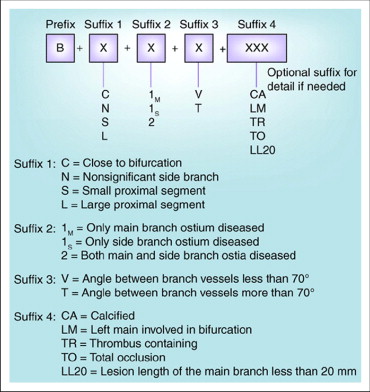I read with great interest the recently published report titled “Serial Intravascular Ultrasound Analysis of Bifurcation Lesions Treated Using the Novel Self-Expanding Sideguard Side Branch Stent.” The investigators evaluated the novel Sideguard side branch stent (Cappella Medical Devices Ltd., Galway, Ireland) in true bifurcation lesions. However, they used a very complicated Medina bifurcation classification, which separates true bifurcation lesions into 3 clinically irrelevant groups (1.1.1, 1.0.1, and 0.1.1). This is in contrast to the Movahed bifurcation classification, which summarizes true coronary bifurcation lesions in only 1 clinically relevant group: so-called B2 lesions (“B” for “bifurcation” and “2” denoting that the side and main branches have significant atherosclerotic lesions at bifurcation site). Furthermore, the Medina classification contains no description of the bifurcation angle or any other relevant features of a given bifurcation lesion, whereas the Movahed classification includes suffixes that can be added to describe the bifurcation angle and other important features of a bifurcation lesion. For example, in their study, Doi et al used only B2 lesions with bifurcation angles ≥50°, main-branch reference diameters (MBRD) of 2.5 to 3.5 mm, main-branch lesion lengths (MBLL) ≤25 mm, side-branch reference diameters (SBRD) of 2.2 to 2.8 mm, and side-branch lesion lengths (SBLL) ≤7 mm. By using the Movahed classification, the investigators could have described the specific bifurcation lesions examined in their study simply as B2≥50° lesions, with additional descriptions of other anatomic features separately, or they could have described the lesions comprehensively as follows: B2≥50°, MBRD 2.5 to 3.5, MBLL ≤25 mm, SBRD 2.2 to 2.8 mm, SBLL ≤7 mm.
The accurate description of specific bifurcation lesions studied in a trial enables other investigators to understand the exact design of such a study and use it for comparative studies. Furthermore, the Movahed coronary bifurcation classification is an easy-to-memorize classification based on anatomically and technically relevant features of coronary bifurcation lesions, as mentioned previously. Figure 1 shows the structural details of the Movahed coronary bifurcation classification.





